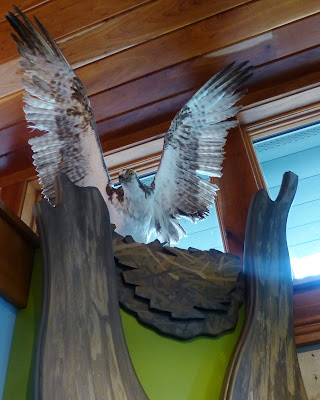Creating a Curiosity Center
What place does taxidermy have in the modern museum? I naturally think about this on almost a daily basis. Even amid program scheduling, monotonous computer work, and development on not one but two new exhibits, I still have room to think about this. It's a good question, and the answer usually materializes when and where I least expect it.
It can be difficult for the average person to form a meaningful connection with the stuffed remains of an animal. The traditional natural history museum displays only a small fraction of specimens in its holdings, and even then visitors have little opportunity for interacting with the specimen--beyond reading a concise label near the dreaded "do not touch" sign. Some institutions remedy this by substituting taxidermy for artificial natural history objects, others just have to find different ways to make their specimens available to the public. We're trying both.
 |
| The KidZibits team worked closely with Museum staff to make sure that our needs and interests were met as they developed and installed our new Curiosity Center. |
A group of hip urbanites spent a week here while they installed the Museum's new Curiosity Center. Thankfully, they didn't seem to mind the rural location one bit. A medley of artists, engineers, and even welders, they each helped us to create an indoor play area to inspire young people to explore nature spaces, unafraid and full of curiosity. As in any natural setting, the Curiosity Center includes a combination of animals--and these are meant to be touched!
The team created strikingly realistic squirrels, a woodpecker, moth, and more which are effortlessly scattered across the Center. While some of our visiting handypeople were still busy with the large elements last week, I stooped down to touch a deer mouse they had created. Like most mice, it was adorable and I quickly noticed that it even had pliable whiskers. Just like that, I was captivated!
 |
| A deer mouse replica stands near a rolling log which interprets a community of decomposers. |
A woodpecker next caught my eye as I marveled from the "forest floor." I took note of the detail painted onto the bird by an expert hand--and was happy to know that while the materials themselves didn't exactly mimic the true texture of a feather or fur, the various animals were carefully constructed to be valuable teaching tools. While our visitors may easily touch this particular bird, another perches in the crook of a tree just above and out of reach. The osprey, gazing down with wings outstretched, is not another replica but one of our own regularly displayed taxidermy mounts. Anyone who has visited our Curiosity Center of days passed would recognize it, and hopefully find some semblance of nostalgia as we bring some old into the new.
 |
| KidZibits created a woodpecker--nibbling on carpenter ants as it clings to a stump on the outside of a slide. |
 |
| An osprey gets a new home high above the rest of the play area in our Curiosity Center. |
 |
| A flying squirrel whizzes by a red-tailed hawk as visitors help it move from one tree to another. At bottom, the squirrel is barely caught on camera as it moves across a zipline. |

